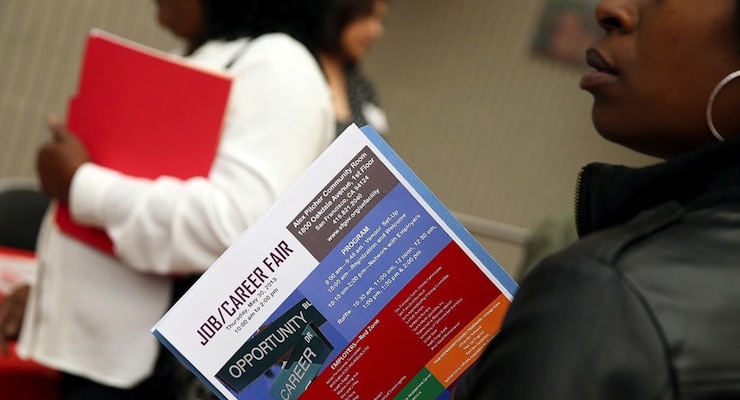

SAN FRANCISCO, CA – MAY 30: A job seeker holds a pamphlet during a job and career fair at City College of San Francisco southeast campus on May 30, 2013 in San Francisco, California. Hundreds of job seekers attended a career fair hosted by the San Francisco Southeast Community Facility Commission. (Photo by Justin Sullivan/Getty Images)
The ADP National Employment Report released on Wednesday showed U.S. private sector job creation rebounded slightly, adding 200,000 jobs in September and beating economists’ expectations. The report is also adding to speculation that the Federal Reserve will raise interest rates later this year in December for the first time since the Great Recession.
Economists surveyed by Reuters had forecast the ADP National Employment Report would show a gain of 194,000 jobs, and private payroll gains in August were revised down to 186,000 from an originally reported 190,000 increase.
The report is jointly developed with Moody’s Analytics and comes ahead of the U.S. Labor Department report on non-farm payrolls released Friday, which includes both public and private-sector employment. Economists polled by Reuters forecast U.S. employers hired 203,000 workers in September, improving from August’s 173,000 increase which was the smallest in five months. The unemployment rate was forecast to hold at 5.1 percent, a near 7-1/2 year low.
“Businesses with more than 1,000 employees contributed over half of the job gains in September, despite weakness in energy and manufacturing,” said Ahu Yildirmaz, VP and head of the ADP Research Institute. “The largest companies appear to be starting to overcome the impacts of weak global demand and the high dollar, while the smallest companies may have pulled back as concerns about the resiliency of the U.S. economy grew and consumer confidence softened.”
The Commerce Department said last week that second-quarter growth as measured by gross domestic product (GDP) was revised up to a 3.9% annual pace. GDP was previously reported to have grown 3.7% in the April-June quarter. However, higher-paying job creation sectors continue to lag far behind lower wage sectors. Manufacturing again posted numbers in negative territory by losing 15,000 jobs in September, the worst showing since December 2010.
The Commerce Department reported on Thursday last week that new orders for long-lasting manufactured durable goods fell 2% in August. The report came after two closely-watched surveys of regional manufacturing activity indicated contraction last month. The Philadelphia Federal Reserve’s regional Manufacturing Business Outlook Survey for the mid-Atlantic tankedto -6 in September from 8.3 the month prior. The Fed’s reading came in far below economists’ expectations for a drop to positive 6.
The Philadelphia Fed’s report marked the second major regional manufacturing survey released this week showing the sector contracting, as the Empire State Manufacturing Survey out last Wednesday showed regional manufacturing activity contracted for a second straight month in September, remaining well below zero at -14.7.
“The U.S. job machine continues to produce jobs at a strong and consistent pace,” said Mark Zandi, chief economist of Moody’s Analytics. “Despite job losses in the energy and manufacturing industries, the economy is creating close to 200,000 jobs per month. At this pace full employment is fast approaching.”
Still, the U.S. economy must create roughly 250,000 per month simply to keep pace with inflation and wages have remained stagnant, the latter has weighed heavily on the Fed’s calculation on the timing and trajectory of planned rate hikes.





